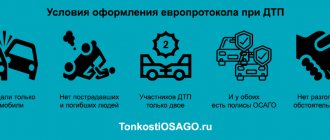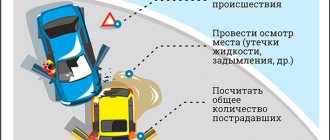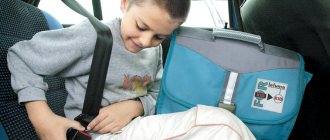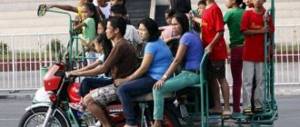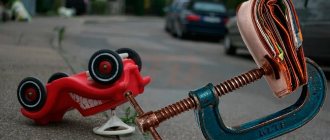Statistics
Dear readers! The article talks about typical ways to resolve legal issues, but each case is individual. If you want to find out how to solve your particular problem , contact a consultant:
+7 (499) 938-81-90 (Moscow)
+7 (812) 467-32-77 (Saint Petersburg)
8 (800) 301-79-36 (Regions)
APPLICATIONS AND CALLS ARE ACCEPTED 24/7 and 7 days a week.
It's fast and FREE !
But first, some statistics. All road accidents can be divided by type:
- Vehicles colliding with each other.
- Vehicle rollover.
- Collision of one vehicle into another stationary vehicle.
- Hitting a pedestrian, cyclist, or animal.
- A car collides with a static obstacle.
- Vehicle falling from a height.
- Other traffic incidents.
The main reasons causing injury to a person are:
- relocation (or collision);
- compression (squeezing, deformation);
- hit;
- penetration of foreign objects (fragments) into the human body.
In this case, injury can be caused not only by the car itself, but also by elements of the road or roadside structures.
For example, there is a widely known case when a passenger was driving at a speed of 120 kilometers per hour with his hand extended out of an open window, and a road sign standing close to the roadway practically tore off the passenger’s hand when the outstretched hand collided with this sign at high speed.
Injuries in road accidents can be varied, sometimes quite complex, but most often there is a pattern: the higher the speed of the car, the more complex and severe the injuries.
The most severe injuries in road accidents are those sustained by impact with:
- door;
- steering wheel;
- the windshield of a vehicle during a frontal collision.
According to road accident statistics, when analyzing injuries that caused death, forensic medicine staff found that:
- more than 52% of injuries that led to the death of an accident victim were caused by deformation of the car body;
- about 40% - from the impact of the victim on the internal parts of the cabin.
In addition to the speed of the vehicle, the severity and nature of the injury can be affected by the form of the collision:
- tangentially;
- side collision;
- windshield;
- make and weight of the vehicle;
- the presence or absence of airbags and seat belts.
According to statistical studies, when wearing seat belts in severe frontal crashes, especially at high speed, the number of traumatic injuries incompatible with life is three times less than without a seat belt.
According to statistics, among those involved in an accident who do not use safety belts, about 46 percent are injured, and 3 percent of those involved in road accidents die.
The picture with the use of a belt is completely different - nineteen percent of injuries and about one percent of deaths from the total number of those involved in an accident.
The most numerous and especially dangerous are:
- neck wounds;
- head, including severe concussions;
- breasts;
- ribs;
- chest organs;
- abdominal cavity;
- spinal injuries.
Among the main causes of death for accident victims, statistics list:
- combination of acute heavy bleeding and shock;
- traumatic brain injury;
- injuries incompatible with life.
In addition to severe injuries, fatalities are often caused by:
- time factor (golden hour rule);
- low level of training of police officers, as well as drivers, who sometimes do not know how or understand how to provide first aid to a victim.
What constitutes damage from a traffic accident? This is damage caused by internal or external elements of a moving vehicle, or injury caused by the car falling out.
There are several types of auto injuries:
- impact by any element of the vehicle structure in a collision with a person;
- moving the victim with one or more wheels;
- falling out of the vehicle while driving;
- impact on the inner surface of the car or squeezing of body parts by parts of the car in the cabin;
- squeezing (squeezing) the body between vehicle elements and foreign objects;
- combined.
According to research results, accident injury statistics show that different parts of the body are injured in different ways:
- most often victims receive various head injuries (about 60% of cases);
- the next most common injuries are fractures or bruises of the legs (approximately 10%);
- the third were hand injuries (every twelfth).
The main causes of serious injury and death were identified as impacts on:
- dashboard;
- windshield;
- steering column.
The severity of the damage often depends on the location of the victim in the cabin - the more nearby structural elements that a person can hit, the greater the likelihood of damage, which is why the most dangerous seats in a car are the front seats.
Mechanism of injury as a result of an accident
When we learn from the media about another accident that happened in our hometown/district, we rarely pay attention to the list of injuries, if any. We have enough information about the general condition of the victims, which is usually provided in such cases.
Meanwhile, damage received by the people in the car at the time of the accident can be caused in different ways. There are many factors that influence the mechanism of injury:
- the location and even the posture of the person at the time of the collision/overturn of the car;
- the speed of the vehicle at the time of the accident;
- type of accident;
- presence/absence of active/passive safety systems;
- whether the driver/passengers were wearing seat belts.
We list the main types of damage leading to injury:
- Impacts are the result of a vehicle colliding with an obstacle, colliding with another vehicle, or overturning a vehicle. According to statistics, this is the most common cause of injury, and damage can occur in any part of the body, especially if passive personal protective equipment is not used. The force of inertia, multiplied by the mass of the body, causes the body to move at the same speed at which the car was traveling, while the car itself rapidly loses speed due to a head-on collision. During side impacts and rollovers, slightly different forces act, and the influencing factors can be very diverse, from car parts to foreign objects located in the car interior;
- compression is a no less frequent and traumatic impact that occurs as a result of deformation of vehicle components and squeezing the body of the driver/passengers, when the car rolls over, as a result of squeezing with a fastened seat belt (in this case, compression is a lesser evil than a blow, which is inevitable in case of non-use RB);
- penetration of foreign objects into human tissues and organs. Typically, such cases are considered as a consequence of an impact, as a result of which car parts are destroyed with the formation of debris (glass, plastic trim elements, metal parts).
- moving - usually happens to those who were unbelted, as a result of which they were thrown forward through the windshield by the force of inertia. The same thing happens to passengers sitting in the rear of the cabin.
You can get injured without a collision/overturning, as a result of careless behavior - there are many known cases of serious injuries as a result of the collision of arms extended out the window with road structures (signs, indicators) and other vehicles.
Assisting a victim in a racing accident
There is a separate classification according to the severity of injuries received, which we will talk about later, noting only a well-known fact: the higher the speed of the car at the time of the accident, the more severe the consequences.
The most dangerous vehicle parts are considered to be:
- doors (in case of side impacts, rollovers);
- steering wheel together with steering column;
- windshield (in a direct collision).
The most severe life-threatening damage occurs as a result of deformation of the body and internal structural elements of the car, as well as impacts on protruding parts of the interior.
The nature of the damage is significantly influenced by the direction of the impact (head-on collision, side impact, tangential impact), the speed of the vehicle and its mass.
The same statistics show that using a seat belt can reduce the likelihood of receiving injuries incompatible with life by three or four times (19% of those wearing a seat belt are injured, 1% die; among those not wearing a seat belt, the statistics are much sadder: 47% are injured, about 3% die ).
Among the organs most often affected in accidents are:
- neck;
- breast;
- head;
- ribs;
- internal organs located in the chest area;
- internal organs located in the abdominal cavity;
- spine;
- legs.
Deterioration of the injured person’s condition, even death, occurs for the following reasons:
- delays in doctors arriving (the so-called “golden hour” rule);
- ignorance of the surviving participants in the accident of the rules of first aid, depending on the type of injuries received;
- incompetence of police officers (in the medical aspect).
What injuries can you get in an accident?
Some of the most common injuries during an accident are:
- fractures;
- bruises;
- other bone injuries.
Much less common:
- dislocations of limbs;
- muscle injuries;
- fractures are often accompanied by bleeding, and with significant blood loss, blood pressure drops sharply, and if the victim is not quickly given first aid, he may die from blood loss;
- Cardiac arrest occurs during a sharp impact with the chest on a hard surface, for example, on a steering wheel, in the absence of an airbag or seat belts.
Puncture wounds in the area of the pleural cavity can be called dangerous, especially when air, when inhaled by the victim, begins to flow through the wound into the cavity itself.
Drawing. Types of injuries in victims of various types of vehicle collisions.
Types of damage to the driver and passenger
An accident can cause injury to any part of the body or several at once. You can distinguish the type of damage visually, but only a specialist can characterize it more accurately after an examination. However, an eyewitness to the incident is able to recognize the type of injury in order to help the victim.
Cranial
The head often suffers in road accidents. After all, when a car suddenly stops, a person leans forward sharply and can be injured on the glass or steering wheel. The head is not secured by anything, so it hits a hard surface, resulting in a traumatic brain injury. It can also be caused by a late deployed airbag.
Passengers sitting in the rear seats receive a concussion or brain injury from impact with the front seats. If the collision is sideways, the head hits the car pillar or door. A traumatic brain injury can be recognized by a wound on the forehead or crown, the back of the head, or a broken face. If it is severe, fluid may leak from the ears, nose, and a visible fracture of the skull bones. A cracked car window indicates a head impact.
The most severe traumatic brain injuries occur in those who are not wearing a seat belt. Another factor in receiving such damage is the high speed of the car, its fall from a great height.
Spine and ribs
Stopping the car abruptly can lead to a dislocation or fracture of the spine. The cervical region is especially often affected. The head sharply tilts down, then it is immediately thrown back, which causes injury. Those who sit with a bent back and a poorly adjusted headrest are at greater risk.
The spine also suffers when a person is not wearing a seat belt. Sharp jerks of the body lead to deformation of ligaments and impacts. The rear passenger may be injured. He is thrown forward with tremendous force. And the blow falls precisely on the back of the person in front.
Injuries to the neck and spine are indicated by increased pain when trying to change the position of the body, turn the head, or move the arms. Sometimes deformation is noticeable. The localization of sensations depends on which part of the spine is injured.
Fractures and bruises of the ribs are caused by contact with the steering wheel. The part can press them inward, resulting in deformation of the bones. Dangerous for ribs and belt. He holds the body in place, and it rushes forward. The consequence is sudden compression and tissue damage.
Watch this video about whiplash in a car accident:
Organs
The most difficult thing to recognize is damage to internal organs, since there may be no traces on the body. However, just because a person shows no outward signs of injury does not mean everything is fine. Damage to internal organs is a dangerous condition that can cause bleeding.
More on AutoLex.Net:
Who is to blame for an accident involving a pedestrian: the responsibility of each participant in various situations with examples
You can understand that they are injured by the victim’s complaints of abdominal pain, which intensify over time and cover an increasingly larger area. The person turns pale, feels weak, feels sick and vomits. There may be hematomas on the skin in the area of injury.
Injuries to internal organs occur due to hitting the steering wheel with the stomach, chest, or when a person is thrown out of the car. Damage can also be caused by an incorrectly fastened seat belt.
Limbs
Arms and legs are also at risk in an accident. The lower extremities are more often affected because they can be injured by the pedals and dashboard of the car. Legs can be broken, sometimes it is impossible to free them from the interior trim. The latter is dangerous because soft tissues and blood vessels are compressed, and necrotic changes may occur. And the limb will have to be amputated.
In the event of a strong impact or poor design of the car (when the engine is carried into the cabin during a collision), the legs can simply be torn off.
Injuries to the upper extremities in accidents occur less frequently. More often these are fractures of the fingers and hands caused by interaction with the steering wheel. Injuries to the elbow bones and forearms are also possible in the event of a side impact or rollover of the car, or ejection of a person from the passenger compartment.
Combined
If there are many injuries of a different nature, the victim is said to have received combined injuries. This happens if the car overturns, or the person in it is thrown out of the cabin by the impact. Associated injuries are more likely to occur when the driver or passenger is not wearing a seat belt. In these cases, different parts of the body may be damaged. And the severity of the injuries also differs.
Combined injuries can be recognized by a combination of signs. The victim usually experiences severe pain, is unable to name its source, or says that there are several of them. The person has difficulty breathing. He may go into shock from unbearable sensations and intoxication. Some experience severe blood loss.
To learn about what a combined injury is and how to carry out therapeutic and diagnostic measures at the initial stages, watch this video:
Table of severity of injuries in road accidents
Harm to health is divided into:
- easy;
- average;
- heavy;
- death.
Any harm to health is determined in accordance with its long-term consequences: the more severe they are, the more complex the harm to health is determined and the more severe the punishment awaits the person responsible for the incident.
Table. Consequences of the severity of injuries depending on the severity of harm to health
| Qualification of the severity of harm to health | Signs | Consequences |
| Heavy | 1.Danger to life. 2. Severe consequences. | Complete blindness. Complete deafness. Completely dumb. Loss of an organ or permanent impairment of its function. General severe pathological conditions. Loss of fertility. Facial disfigurement. |
| Moderate | 1.No danger to life 2.Good prognosis for restoration of health by more than 70% | Long-term (more than 21 days) health disorder. Loss of ability to work by no more than 30%. |
| Easy | Prognosis for full recovery of more than 95% | Short-term health disorder (less than 21 days) Loss of ability to work not more than five percent |
Severity of injuries received
The ability to save a victim in an accident also depends on how severe the injuries were. The degree of their severity also determines the amount of compensation payments for damage to health. And it, in turn, is established depending on the consequences of the damage.
Lightweight
Light injuries are considered to be those that resolve within a period of up to 21 days and do not cause more than 5% loss of ability to work. Usually, they can determine in advance that the victim will recover and there will be no negative consequences for his health. Light ones include, for example, simple dislocations, fractures of 1 - 2 ribs, ligament ruptures, compression syndrome (if it does not cause severe impairment of body functions).
More on AutoLex.Net:
Unsuccessfully opened the door - accident: situations with the passenger and driver's doors, when will insurers pay, and when will you have to get out on your own?
Average
Harm to health of moderate severity is classified according to two criteria:
- a person has a violation of the functioning of organs or systems lasting up to 21 days;
- his ability to work has been lost by no more than 30%.
This happens with injuries that are not life-threatening. And the degree of recovery can be predicted; it will be 70% or higher. These are, for example, fractures of three ribs, soft tissue injuries, loss of a finger or toe, and hearing loss in one ear. But in general, the degree of severity should be assessed by an expert commission.
Heavy
Serious damage to health is caused by injuries that pose a threat to life or cause serious consequences. Their list is more extensive than with an average degree. It is in Order of the Ministry of Health of the Russian Federation No. 194n dated April 24, 2008. This is, for example:
- head wounds, including when the brain remains intact;
- skull injuries and fractures;
- neck injuries affecting the larynx, pharynx, esophagus, trachea, thyroid gland;
- spine fracture;
- spinal cord contusion;
- chest wounds with or without damage to internal organs;
- penetrating abdominal injuries;
- pelvic wounds;
- damage to the internal genital organs;
- coma, sepsis;
- loss of an organ or loss of its functions.
The list of serious injuries is much more extensive. But a forensic medical examination must also establish that this is a grave degree.
First aid
Delay in providing first aid to victims often leads to the death of the wounded. First aid for any accident is divided into self-help and mutual aid.
There are three approximate organizational stages of providing assistance in an accident, which can be provided by drivers, passengers, and eyewitnesses of the incident:
- • emergency assistance at the scene of an accident (extracting the victim from the car and emergency assistance in case of a threat to life);
- calling an ambulance;
- transportation of all victims to a medical facility.
To minimize physical harm in case of injuries, the following algorithm of actions is recommended:
- Stop further traumatic effects on the victim (pull him away from the burning car, if possible, pull him out of the wreckage, etc.).
- Until the ambulance arrives, support the wounded person’s vital body functions (heartbeat, breathing).
- Meet the ambulance and transfer the victim to the doctors.
- If medical assistance is delayed and it is possible to evacuate the victim yourself, carry out transportation.
In critical situations, not everyone can concentrate and react soberly to what happened, not panic, and not take the wrong steps.
The sequence of first aid is as follows:
- stop the bleeding;
- establish whether the victim is breathing on his own; if there is no breathing, perform artificial breathing either until signs of life appear in the wounded person, or until the ambulance arrives;
- feel the pulse; if it is absent, perform an indirect cardiac massage until the doctors arrive;
- for fractures - apply a splint or at least fix the injured limb with available materials;
- treat wounds, apply a bandage.
When carrying out emergency measures, try, if possible, not to cause unnecessary pain to the wounded person.
Classification of injuries according to their severity
The severity of the injuries sustained in the accident is the primary factor. The ability to save him and at the same time minimize the negative consequences of an accident (for example, disability) largely depends on the correct identification of how severely injured the victim was.
This is not an easy task, especially if the person providing assistance is not a medical professional. From this point of view, it may be useful to study the table of the severity of injuries in road accidents in correlation with health consequences in the medium and long term:
| Severity of injuries received | Main features | Health implications |
| Lungs | The probability of full health restoration is more than 95% | Loss of ability to work in the long term does not exceed 5%. The period of incapacity for work lasts no more than 21 days |
| Moderate | There is no threat of death, the probability of full recovery exceeds 70% | Permanent disability up to 30%. The time required to restore health exceeds 21 days. |
| Heavy | There is a threat to life, severe consequences of the injuries received | Loss of vision, hearing, complete muteness. Loss of one of the organs or permanent loss of its functionality. Facial disfigurement, loss of reproductive functions. Pathologically severe permanent conditions. |
In more than 70% of cases, death in road accidents is a consequence of untimely or unqualified provision of first aid to the victim.
Eyewitnesses of the accident, other drivers and passengers, as well as those not injured in the accident are required to demonstrate a civic position, which consists in taking the following measures:
- providing emergency assistance to injured people (extracting them from a vehicle, providing emergency measures in the presence of a threat to life);
- calling an ambulance;
- providing your own transport or assistance in transporting victims to the nearest medical facility.
Providing first aid to victims of an accident
An approximate algorithm for providing emergency assistance aimed at minimizing the consequences for the injured body is as follows:
- first of all, it is necessary to exclude factors that have a traumatic effect on the participant in the accident (pull him out of the car, if this is impossible, try to free the compressed parts of the body, pull the victims away from the burning vehicle);
- if the wounded person is in critical condition, support the functioning of vital organs (heart, lungs) until doctors arrive;
- upon the arrival of doctors, describe as briefly as possible the condition of the injured person;
- if qualified medical care cannot be provided in the near future, transport the victim yourself to the nearest medical facility.
We note that witnesses to an accident are not always able to make adequate decisions. If you panic and cannot pull yourself together, it is better to refrain from providing first aid and let others do it.
Algorithm for providing emergency assistance in case of accidents:
- if there is heavy bleeding, take measures to stop it;
- determine the presence of breathing in the injured person, if not, begin artificial ventilation of the lungs either until doctors arrive or until respiratory function is restored;
- simultaneously with breathing, the presence of a pulse is checked. In the absence of heartbeat, an indirect massage of the heart muscle is performed until qualified medical assistance arrives;
- if signs of fractures are found during examination, apply a splint (fix the limb) using available materials;
- treat wounds, it is highly desirable to disinfect them;
- minimize the increase in pain experienced by the victim during emergency care.
Now let’s move on to a more detailed consideration of the classification of injuries sustained in road accidents.
Minor injuries
This category includes injuries, the consequences of which disappear within three weeks, while the loss of ability to work, expressed as a percentage, does not exceed 5. As a rule, based on the examination of minor injuries, it can be concluded that they will not cause negative irreversible consequences for body. Such injuries include bruises, dislocations, tendon ruptures, single fractures of limbs/ribs, tissue compression that does not lead to dysfunction of other organs.
Moderate injuries sustained in road accidents
Attribution of damage to this category is possible if two conditions are met:
- the length of stay on sick leave exceeds three weeks;
- as a result of the injuries received, a disability of 30% or less was recorded.
Despite the presence of permanent consequences for the health of a participant in an accident, there are no threats to life when receiving such injuries, and restoration of lost functions will be observed in proportions exceeding 70%. Such injuries include multiple fractures, extensive soft tissue damage, hearing loss in one ear, and loss of a finger of the lower/upper limb. It is possible to receive disability without loss of ability to work, but in general, the assessment of the victim’s condition is carried out by an expert commission.
Transportation of victims with spinal injury
Severe injuries
Injuries sustained in a road accident are considered severe if their long-term consequences are severe or irreversible, or if they pose an immediate threat to life. The list of such injuries is presented in Order of the Ministry of Health No. 194, approved on April 24, 2008. In particular, the following pathological conditions include severe injuries:
- head injuries that do not affect the brain;
- fractures of the skull bones;
- neck injuries leading to dysfunction of the pharynx, larynx, thyroid gland, trachea, and partially the esophagus;
- spinal cord injuries;
- spinal fractures/displacements;
- rib fractures with consequences in the form of damage to internal organs;
- pelvic area injuries;
- penetrating wounds of the abdominal cavity;
- damage affecting the genital organs (external and internal);
- loss of an organ, complete or partial loss of functionality;
- sepsis;
- coma state.
This incomplete list is provided as an example; the list of serious injuries is much more extensive. We do not present it because it contains medical terms that the average citizen is unlikely to be able to correctly interpret. In most cases, such damage leads to disability with loss of ability to work. The degree of severity, as in the previous case, is determined by a forensic examination.
#Accident#Safety#Accident#Fracture#Damage#Airbags#Seatbelt#Collision#Injury
How to file a claim for damages
Compensation for damage to the victim’s health includes:
- wages or other income lost during incapacity;
- treatment costs (this includes additional food, medications, and other means of caring for the wounded);
- expenses for nurses, prosthetics, treatment in a sanatorium;
- costs for professional retraining.
Damage to health caused by a road traffic accident is compensated only in court.
To initiate the process, it is necessary to file a claim for compensation for personal injury and attach to it copies of documents that confirm the facts stated in the statement of claim.
Compensation for injury to health is paid by the person found guilty of the accident, and, according to the rules of jurisdiction, the claim is considered by the district court chosen by the applicant.
There are three options here:
- at the place of residence of the plaintiff;
- at the place of residence of the defendant;
- at the scene of the incident.
Figure 2. Sample statement of claim for compensation for personal injury.
Payment procedure for injuries
The insurance company of the person responsible for the accident and the driver himself through whose fault the accident occurred are considered liable for damage caused in an accident.
Previously, until April 2015, the victim had to collect checks, documents confirming the costs of recovery, and the insurance premium could be received after complete recovery.
An important nuance: if a car of an organization or enterprise is involved in an accident while performing work duties, then the injured driver will be considered to have suffered a work-related injury.
In such cases, the injured employee has the right to additionally file a claim for work injury as a result of the accident against the employer. But he cannot count on any benefits after a work injury if the damage to health is fully restored.
If the guilty party in an accident was injured, but has insurance under MTPL, there will be no evidence that the culprit was intoxicated, then he can also count on compensation for health damage under MTPL.
Now the victim does not have to wait for recovery; it will be enough to present to the Investigative Committee a certificate from a medical institution indicating the injuries received.
Documents required to receive payment under compulsory motor liability insurance if the victim was injured in an accident:
- passport;
- bank details where insurance payments must be transferred;
- certificate of accident;
- documents from the traffic police, which will indicate the culprit of the accident;
- medical certificates indicating the nature of the injuries and their severity;
- conclusion of a forensic medical examination on the degree of disability.
The insurance company has no right to require any additional documents from the victim.
Of course, it is better not to get into a traffic accident. Of course, it is better to drive the vehicle carefully, observing all traffic rules.
But if you are in an accident, it would be better for everyone that the participants in the accident have at least minimal knowledge about injuries, how to help the victim, and how to subsequently receive compensation for damage to health.
The damage has been recorded: what next?
The procedure for dealing with road accidents involving victims requires that traffic police officers be called to the scene of the accident, who will record in documents the fact of their presence. After determining the severity of the damage to health, you should contact the insurance company of the person responsible for the incident to receive the established compensation.
Payments under compulsory motor liability insurance for damage caused to health are quite large, but there are cases when they do not cover real expenses. For example, the victim needed treatment, the cost of which exceeds the established payments. In this case, you should go to court. You will also have to file a claim in court if you want to receive compensation for moral damage. If you go to court or the insurance companies are unwilling to make the required payments, you should hire a qualified lawyer. His fees can be included in legal costs and these costs can be reimbursed by the defendant.
Read more about how compensation for personal injury occurs in an accident.
